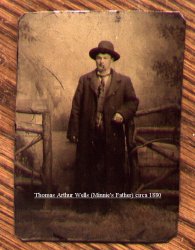
MAY CONTAIN NUTS

Search Shorpy
SHORPY ART

Framed or unframed, desk size to sofa size, printed by us in Arizona and Alabama since 2007. Explore now.
Join and Share
Ad-Free Shorpy
Shorpy is funded by you. Patreon contributors get an ad-free experience.
Learn more.

Recent comments
- Illuminate us
- I remember it well
- I can't prove it
- Complicated then, forgotten now
- Bryan-Stevenson
- Skinny is as skinny does
- How do you rest in peace
- Riding the footboards
- Alas, hidden from view
- Baldwin Diesels
- Exclusive pump
- Bananas, Oysters and Smokey Joe
- Details, Details
- What's that building to the left of the tower?
- Coal Barges
- Bromo-Seltzer
- Inner harbor
- The Basin
- What a headache!
- Giant stepladder?
- Yeah, it was cold
- Love those coats
- Link & Pin Days Remnant
- Baldwin 62303
- Baldwin VO-1000
- Cold
- No expense spared
- Tough Guys
- What's your hurry, where's your hat?
- Sheriff's Signature
Member Photos
The Shorpy
Print Emporium
Print Emporium
Search Shorpy
Search results -- 30 results per page
- Blacksmith: c. 1900
- Two children talk to a blacksmith standing in the doorway of his forge. Photograph by Frances S. ... Posted by Ken - 09/08/2011 - 6:27pm -
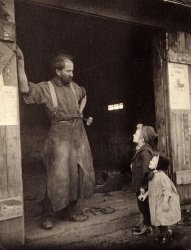
- The new blacksmith in town
- ... being my Great-great-grandfather, Thomas was the local blacksmith and a farmer in the Bellpointe, Ohio, area. Bellepointe is, or was, ... the later part of the 1800's. Grandpa Thomas Wells was a blacksmith there. This picture is the local hearse of the horse drawn carriage ... Posted by swiggy - 04/11/2009 - 8:25pm -
- Southern Pacific blacksmith shop. In Oakland?
- ... As far as I know, this is a photo of the crew at the Blacksmith Shops for the Southern Pacific Railroad in Oakland, California. My ... card for World War I listed him at the railroad in the blacksmith shop. By the '30's, he'd started a laundry business elsewhere in ... Posted by bowdidge - 09/20/2011 - 8:22pm -
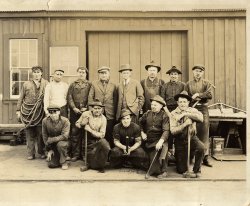
- blacksmith shop
- Inside shot of a blacksmith shop. Don't know place it was taken. Appears to have a car from the ... Posted by kevhum - 05/16/2007 - 12:28am -
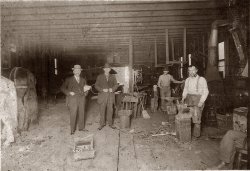
- Park Your Wagon: 1901
- ... Back when you could leave your ice-wagon at the blacksmith's unlocked.
Washington, D.C., circa 1901. "View of E Street ... getting shoed. - Dave]
Appropriate ... that the blacksmith saw fit to put iron bars on the windows. But he is, after all, a ... Posted by Dave - 08/26/2020 - 1:34pm -
![Park Your Wagon: 1901 Back when you could leave your ice-wagon at the blacksmith's unlocked.
Washington, D.C., circa 1901. "View of E Street S.W. between Delaware Avenue & First Street, looking northwest." 5x7 inch glass negative, D.C. Street Survey Collection. View full size.
Maybe so, but ...I see bars on the windows and the horses are nowhere to be found.
[They're inside getting shoed. - Dave]
Appropriate... that the blacksmith saw fit to put iron bars on the windows. But he is, after all, a blacksmith.
Ice Did Not KnowI knew what manufactured ice was but not Kennebec ice. Well, as usual, a quick Google search answered all the questions. It's interesting that in the days before modern refrigeration, ice cut from the Kennebec River in Maine could be kept frozen to be distributed around the country.
Shoed is a peculiar wordAnd for some peculiar reason, I can't figure out what that road surface is.
All GoneIf I'm reading the map correctly, this is now covered by the interchange of 695 and 395. Not nearly as charming.
Hard to steal without the engineYeah, I always felt safe leaving my ice wagon unlocked as long as ol' Nellie was inside getting fresh shoes.
Well-dressed horsesHorses get shod, not shoed. That is, unless you are asking them to leave the room, in which case it’s spelled “shooed."
Busy Siebert: fast farrier, skilled shoer or budget blacksmith?Or is there a tavern across the street where drivers can refresh while waiting?
(The Gallery, D.C., D.C. Street Survey, Stores & Markets)](https://www.shorpy.com/files/images/SHORPY-40240a1.thumbnail.jpg)
- "Wrecking": 1939
- June 1939. "Blacksmith shop now used for auto repair. Glendive, Montana." A strong ... Administration." View full size.
The vanishing blacksmith My father-in-law was born and grew up in Glendive. His father ran ... and would stop and listen. The banging and clanging of the blacksmith could be heard anywhere and indicated the center of activity in ... Posted by Dave - 12/09/2017 - 10:20am -
!["Wrecking": 1939 June 1939. "Blacksmith shop now used for auto repair. Glendive, Montana." A strong horseshoe motif here, architecturally speaking, in addition to the giant pile of actual horseshoes. Roofline of alphabetical anvils by Wile E. Coyote. "Wrecking" by "Joe Balison," who seems to be a fan of quote marks. Medium format negative by "Arthur Rothstein" for the "Farm Security Administration." View full size.
The vanishing blacksmithMy father-in-law was born and grew up in Glendive. His father ran a cartage business with mules and he would accompany him for deliveries in neighboring towns. He told me that he would arrive in a new place, and would stop and listen. The banging and clanging of the blacksmith could be heard anywhere and indicated the center of activity in town. He always headed for the noise. He joined the army in 1938, and when he returned after the war, all the blacksmith shops were gone or repurposed. This photo is an example of the change.
Anvils $Today just one of those anvils would be worth close to $1000.
[Those are plaster anvils. -Dave]
"Before" the "philistine" "Joe Balison"From a happier time, the C.S. Johnston Blacksmith shop, without any quotation marks and with all anvils still on parapet.
CrisafulliCrisafulli Inc., a metal fabricator and pump manufacturer, is in business in Glendive. With that name and location there has to be a connection!
GlendiveThe town has the distinction of being the smallest of the 210 television markets in the United States, according to Nielsen. It has 4,370 TV homes, well behind #209, which is North Platte, Nebraska, at 14,370.
truck ID1928-1929 Ford. The front doors are Ford car; the rest of the illfitting body aftermarket or salvaged from another make.
Any takers?I would bet big money the letters on those anvils were once horseshoes.
(The Gallery, Arthur Rothstein, Cars, Trucks, Buses, Horses)](https://www.shorpy.com/files/images/SHORPY-8b17793a.thumbnail.jpg)
- Ramshackle Storage: 1900
- ... name for that rather charming rolling structure?
Blacksmith Shop? The one-story brick building in the left mid-ground might be a blacksmith shop. The clues are the sizeable central chimney with the rain cap, ... Posted by Dave - 10/07/2015 - 11:23am -
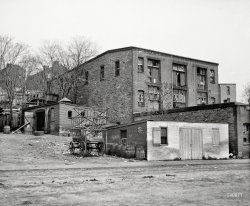
- Man of Steel: 1942
- ... by, some right next to the "heater".
Grandad's blacksmith shop That looks a lot like my grandad's blacksmith shop - where he fixed everything except the crack of dawn and a ... Posted by Dave - 06/24/2015 - 11:48am -
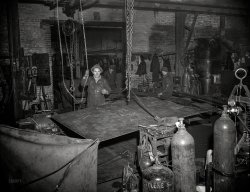
- Anvil Chorus: 1905
- ... View full size.
Surprisingly clean! For a blacksmith shop. Someone needs to pick up the L square though.
Preparing ... they have access to a forge at school.
My friend the blacksmith Sending this to anvilbikes.com, I know he'll appreciate it.
... Posted by Dave - 08/22/2012 - 9:30pm -
![Anvil Chorus: 1905 Washington, D.C., circa 1905-1910. "McKinley School shop." Side note: The McKinley track team was called the Blacksmiths. Harris & Ewing. View full size.
Surprisingly clean!For a blacksmith shop. Someone needs to pick up the L square though.
Preparing the students of today ... ... for the careers of yesteryear! Reminds me of Junior HS in the early 1970s and a course called Industrial Arts, which taught some useful things. But it also had a segment on typesetting (!) That was probably the equivalent of learning blacksmithing on the eve of the automotive age.
For some schools......today is yesterday, it would seem. About 30 years ago, our newspaper converted to "cold type," a paste-up, photographic and offset printing process that was the bee's knees then, but obsolete now. Our local area community college sent us an "intern" that summer who was majoring in hot-lead Linotype operation. We sure chuckled, and he was flabbergasted. Just the other day, my grandson began making a wooden goblet in "shop." I'm willing to bet the community college he might attend is teaching newspaper paste-up right about now, while its graduates will be faced with desktop publishing, Internet technology, and the probable demise of paper-based newspapers as we know them.
Can you say CO poisoning?I see about 6 coal fired forges with not much ventilation other than a few open windows. Maybe the contraption on the back wall is some kind of vent system?
Hardly yesteryear!Blacksmithing is a fantastic way to introduce students to metal, its properties and possibilities. It is one of the great "DIY" skills. Plus, understanding the history of an art is always beneficial, and hands-on, practical exposure, when possible, is best. Kids today are lucky if they have access to a forge at school.
My friend the blacksmithSending this to anvilbikes.com, I know he'll appreciate it.
Well VentilatedEach forge has its own hood and vent.
Clang, clangWow, imagine the racket in this room! No ear (or eye!) protection in those days...
On reading the title, my first thought was of David Lang percussion solo of that name. Only after I Googled "Anvil Chorus" did I realize the phrase was better known from Verdi's Il Trovatore.
I'm happy I got to work in a metal shop for a time a few years ago when I lost my software job. It was some of the most satisfying work I've done...
Nothing wrong with "old" technologyThe comments on industrial arts strike close to home. In junior high school (now renamed "middle school") my shop class included setting type by hand. Sure, learning paste-up today would leave you baffled when facing a computer... except that paste-up is the analogue to computer layout, just as cold type was the analogue to hot lead. But it's probably a pied type tray that steered me into graphic design.
There's no reason not to learn something because it ain't the newest and "bestest." Most often, learning the foundations of your craft helps makes you better at present-day applications (and a heckuvalot more appreciative of new tools).
And let's not forget that using old technology can give you a niche in a crowded market. How else would you explain handmade paper, successful letter press publishers, or The Woodwright's Shop?
Steve Miller
Someplace near the crossroads of America
Shop classWow, it's a high school shop class and not a single bong is being made. Times sure have changed!
Fantastic detail!As for ventilation, you can just see the edge of the roof vent, basically a skylight. The big motor at the back center is the blower -- the snail direction is blowing down into the floor.
You can see a pipe coming up from the floor to the forge, right below the arm of the blurry boy on the extreme near left. I'm not familiar with that pattern forge, but that hood isn't just for decoration.
The other motor at the back also appears to run a blower, appears to exhaust up like a chimney, and has a hood attached. I'm assuming, then, the small blower blows the forge, the larger one draws through the forge hoods as an exhaust.
The exhaust motor -- a variable speed DC according to the wall controls -- also drives a short lineshaft. There's a power hammer on the left end (below the clock and anchor), a pedestal grinder behind the boy with his hands on his hips (note the larger drive pulley to increase the driven spindle speed) and a small drill press seen right under the triangular fume hood on the right.
Buffalo Forge may well have made all three tools, in addition to the forges themselves.
Anyone notice the boy looking into the room through the double doors at the back left?
Fantastic description by DocNAnd a view of the forges in more detail at another high school. http://www.anvilfire.com/bookrev/buffalo/p256_det.htm
Old SkillBlacksmithing is an old skill but that doesn't mean it's a dead skill. Think of these guys next time you buy a set of wrought iron railings for stairs or a custom design gate for your yard. These are the skills that make those things.
LightingI LOVE the lights hanging in the foreground! They look like they have an electric bulb, but they're clearly modeled like a gas lamp.
[They are gas lamps. - Dave]
(The Gallery, D.C., Education, Schools, Harris + Ewing)](https://www.shorpy.com/files/images/15198a.thumbnail.jpg)
- Los Angeles: 1899
- ... on the right is the Bradbury mansion.
The blacksmith shop at the bottom is on Hill Street.
The grand house on the ... The Plaza church is still there today.
The Village Blacksmith At bottom is the workshop of A.L. Nies:
A.L. Nies came ... Posted by Dave - 07/26/2012 - 4:58pm -
![Los Angeles: 1899 Circa 1899. "General view, Los Angeles." The righthand section of a three-part panoramic series. Detroit Publishing Company glass negative. View full size.
Shorpy Does It Again!Just a spectacular view that's reaching back over a hundred years. The architecture has so much character. The topography can clearly be seen as a force to reckon with.
LA localeThis looks like the general area I lived in for years. Any chance we can see more of the panorama? Would love to get some street names. Since LA tends to raze everything and build anew, longstanding architectural landmarks are few and far between.
WOWGreat house at the right side of the picture, wonderful details. It's probably gone now. This photo helps keep it alive!
The stairs to Los AngelesI can almost see Arturo Bandini climb those stairs, eating oranges and smoking. Although that would have been some 30 years later.
BSBefore Smog -- this shows a totally different L.A. from what we all know and I, who was born there and lived there for many years, can hardly believe my eyes. We think of L.A. as flat but it is really surrounded by hills on three sides! What a shame there is no trace of those gorgeous Victorian-era buildings. Can anyone place the location?
Look out below! Check out the outhouse perched halfway up the hill. I don't think I'd care to live in one of those houses directly downslope from it!
ModernThe most amazing building to me is the one exactly halfway up the left side of the photo, the one whose side is covered with large triple windows. It looks totally modern. Nice flat wall with no adornment. The windows are simply punched into place and have dark frames to blend with the dark glass. The top floor's simple Cupid's bow dormers. A very clean look without all the frilliness of the other buildings.
My hometownI can't say how pleased I was to see this on Shorpy this morning. I'm a Los Angeles lifer and love it, but L.A., as has been noted by other commenters, is not what you'd call a history-conscious town.
I watch old Dragnets on Hulu just to see the shots of L.A. in the '60s, so a pic like this, peeking back into the 19th century, is just a delight.
Stair mastersWithout the caption I would've guessed this was San Francisco. I had no idea Angelenos had so many stairs to climb.
That great house on the rightis the Bradbury mansion.
The blacksmith shop at the bottom is on Hill Street.
The grand house on the leftThe Crocker Mansion.
Broadway and Franklin.We are looking at Bunker Hill from the Old Courthouse. The Hall of Records is yet be be constructed. The intersection in the foreground is Broadway and Franklin Street. Franklin, which no longer exists, would be where the parking west of the Criminal Courts Building is.
The Court Flight, a funicular railway, would be built in 1904 connecting the intersection of Court Street and Hill Street (visible up on Bunker Hill) with Broadway below. So clearly this dates the photos as before 1904. Its sister, Angel's Flight, would be built down the way at 3rd and Hill (off the left edge of the photo) in 1901.
Here is my source. It is an excellent site with parsed post card views of the area:
Start here for background (including a colorized version of our photo!):
http://www.csulb.edu/~odinthor/socal5.html
Then continue here:
http://www.csulb.edu/~odinthor/socal6.html
Bunker HillThis is Bunker Hill on the NW edge of current downtown LA. The last standing Victorian houses were razed in the 60s and the hill partly levelled for development of the music center and hotel district. The large house to the right is the Bradbury mansion of 1887.
The Music Box Isn't that Mr. Laurel and Mr. Hardy, right after they delivered the piano?
Just mindblowingWhat an amazing image!
So I'm guessing that we're looking west/southwest and the ridges in the distance are Baldwin Hills (extending in from the left of the frame) and the Santa Monicas (from the right)? Just WOW.
Watch your stepDowntown LA is perched on the edge of some very hilly terrain. The driveways deliver you right up to the front doors today.
Since I was not alive to see these homes, it's jarring to see the long and meandering stairways leading from the street to these banker-lawyer type homes. It's quite a journey from porch to horse and carriage.
Nobody Walks In LA. Now. Not so then.
Very early cellphone tower?Up on the left horizon. Either a cellphone tower, or the worlds largest lightning rod!
[It's an arc lamp. - Dave]
Pneumonia HallThe Lewis Bradbury house of 1887 (on the right) was at Court and Hill Streets. Bradbury was a property developer who died in 1892, before the completion of the building he is known best for, the Bradbury Building on Broadway.
Later the house was converted to apartments. Harold Lloyd, who lived there when he was starting out, dubbed it "Pneumonia Hall." It was torn down in 1929 for a parking lot.
SuspectThis can't be L.A. There are people out walking.
Los Angeles, 1880How about this photograph by Carleton Watkins from the J. Paul Getty Museum of the Plaza in Los Angeles from 1880? The Plaza church is still there today.
The Village BlacksmithAt bottom is the workshop of A.L. Nies:
A.L. Nies came into Los Angeles in 1882 and established his blacksmith shop near the present Hotel Broadway. He liked the friendly little town where passersby called each other by name and spoke of personal affairs to man, woman and child. For sixteen years he was content. Then the devil of Progress began to alter landmarks and inundate the streets with "foreigners." More here.
East Coast InfluenceTo see Los Angeles back then is like looking at an East Coast city.
Regarding "Modern" commentThe "modern" looking building is the north non-street-facing side of the Tajo Building, built in 1897 on the northwest corner of 1st and Broadway. Since this side was not meant to be seen from the street, it was kept as simple as possible. The smaller image is taken from a colorized postcard circa 1905. The large view of the front and side dates from about 1942.
Bunker HillThis is Bunker Hill in Los Angeles where I grew up in the 1940's through the 1960's, long after this photo was taken. Many of these buildings survived into my era, though, so I remember them. Many more had been replaced by larger apartment houses and residential hotels as the area changed from the refuge of wealthy Angelenos, as it was when this photo was taken, to become home to lower income working families, artists, writers and the elderly. I know all the streets visible here. It is wonderful to see the Hill in its youth when everything seems so new. You can almost smell the newly cut lumber and fresh paint. I love the Hi-def detail of the photos in the Archive because it enabled me to identify the Castle which is one of the Victorian buildings my family owned. It is the light colored building with the dark roof in the background just to the right of the northern slope of the Baldwin Hills in the distance. It sat on S. Bunker Hill Ave. What a thrill to see it. None of the buildings in this photo survives. It was all razed in the 1960's in the name of urban renewal. What an irreplaceable loss.
the hillBunker Hill in L.A. was once a neighborhood of the wealthy. In the 20th century it went into decline as more multi-unit apartments were built and it became a cheap neighborhood for transients, drug addicts and working poor. It served as a backdrop of many American noir films and of one excellent docudrama about the Native American population of Los Angeles called "THE EXILES". This semi-ghetto was razed in the 1960's to make room for the Music Center and more steel and glass towers. L.A. author John Fante moved there in 1929 and his first and last novels ASK THE DUST and DREAMS FROM BUNKER HILL both come out of his experience there.
Angels FlightAm I right in assuming that the slope in the center would be the site of the Angels Flight funicular railway?
[See this comment below. -tterrace]
(The Gallery, DPC, Los Angeles)](https://www.shorpy.com/files/images/4a05813a.thumbnail.jpg)
- 40th Street Shops: 1942
- ... Back to the days of the blacksmith: The only tools seen here are two hammers, a wrench and a broom. ... for many years (1906-1939). His official title was blacksmith, although he did metal fabrication and repair as well. Thanks for ... Posted by Dave - 06/16/2017 - 11:43am -
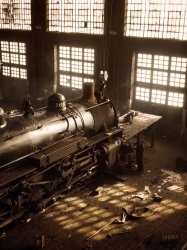
- Herald Square: 1908
- ... the New York Herald newspaper building (with its clockwork blacksmith bell-ringers and electrified owls), Sixth Avenue elevated tracks, ... Posted by Dave - 12/02/2020 - 2:40pm -
![Herald Square: 1908 New York circa 1908. "Herald Square." Panorama composed of two 8x10 inch glass negatives, digitally merged, showing Broadway at 34th Street. Landmarks include the the New York Herald newspaper building (with its clockwork blacksmith bell-ringers and electrified owls), Sixth Avenue elevated tracks, New York Times building and Hotel Astor. Detroit Publishing Co. View full size.
James Gordon Bennett MonumentThe New York Herald Building was built in 1893 and demolished in 1921. The statue of Minerva, the clock and two owls were saved and are now part of a monument to James Gordon Bennett.
The Mighty HippodromeThe largest theatre in the world at the time, the Hippodrome, can be seen far down the tracks on the right.
Hotel Normandie"Absolutely Fireproof"
Made of 100% Asbestos.
Wow!Just WOW!
An amazing photoThe details are unbelievable. Hours can be spent just studying this photo and I likely will.
"Electrified" owlsSo what did Herald's "electrified" owls do? Light up or move? And what is the tall skinny building just left of the Hotel Astor?
[The owls' eyes lit up at night. The skinny building is the New York Times. - Dave]
Can you find?A head without a hat. I couldn't.
Too much... This one is giving me data overload! So much to see in the image!
It must be a warm Spring or Summer day because I see a lot of men sporting skimmers (flat topped straw hats) and the women are wearing blouses with shorter sleeves and fancy hats.
Toward the lower left of the photo we see a cab (horse drawn type) with the driver, in his top hat, waiting patiently. I suspect that I can see a slight smile on his face. Perhaps there is a pretty girl in his field of view.
Then, there are the two members of the constabulary conversing together, in the lower center of the picture. maybe they are talking about going over to the Lunch wagon on the far right to grab a bite to eat.
What, I ask, is the "House of Hits"? That phrase seems to me to right out of the early '60s Motown, not 1910 New York.
Then there is the Hotel Normandie - Absolutely Fireproof!
It seems that Otard Brandy is still available, even today!
I find it a bit hard to believe, but there seems to be a casino in Midtown Manhattan.
I can't forget Lucio's Pearls. They defy detection! and right above them we have "Paul Jones Pure Rye - Remember the bottle!"
There is so much more to take in, in this photograph.
[In answer to your questions: Jos. W. Stern ("The House of Hits") was a music publisher. The Casino was a theater at 39th and Broadway. - Dave]
80 minutes apartThe glass plates making up the panorama, exposed at 12:04 and 1:24 p.m. Click to enlarge.
Still Where The Action Is!I So LOVE this photo! I would give almost anything to be able to go back to this very spot for a few days to shop, sightsee and experience life during this time. The buildings are lovely, the clothing elegant, the cabs very dapper. I will be studying this one for a long while. Thank you Dave posting this one and for such a wonderful merger of pics.
Herald SquareThat answered my question about why the two clocks had different times.
[There's only one clock here. The dial on the right is a wind rose. - Dave]
FoxyThat Fox Real Estate branding would stand the test of time by today's standards, what a classic. Although the fox better watch out for that self-stropping razor up above.
DaredevilWho are those people on the elevated tracks in the distance? And what are they doing? One looks like a kid on a bicycle, dropping something on the people below.
[That's a man standing with his hand on the railing. - Dave]
Jaywalkers everywhereI have no idea how I could safely drive that street without flattening a well dressed pedestrian or two. The most I can see vaguely in the way of traffic safety is a sign on a lamppost warning about slow moving vehicles. Not even a bollard in sight.
Streetcars or cable carsAre those streetcars or cable cars? The center slot between the rails could hold either the electrical source for streetcars (the "conduit" type) or the moving cable for cable cars. I don't seem to see any trolleys on the cars or overhead trolley wires.
[New York's streetcars drew their power from an underground electrical supply. - Dave]
All those peopleDidn't anyone work? This must be the ultimate Shorpy photo, almost too much to fathom. The city of Vancouver, B.C., had a population of 70,000 in 1907; today the greater Vancouver area is 2.25 million, which most Canadians think of as an unlivable population.
Credit where credit is due.Don Y's post was just fabulous. Thank you Dave and thank you Don Y !!!!
Herald Square ParkNice 2007 article in the New York Times about the statue of Minerva and her bell ringers, "Stuff" and "Guff" (or "Gog" and Magog"), seen here atop the Herald Building. The Herald Building was demolished in 1923, the statue stored, and then in 1939-40 permanently installed back in Herald Square Park.
Present day Herald Square Park as well as the adjacent Greeley Square Park are gores--that is, triangular. Several New York City parks are gores.
But, in front of the Herald Building, is the statue that of Horace Greeley, publisher of the rival Tribune?
The horseless hansomThere is a very interesting cab (?) with a driver up behind in the middle right. Can anyone ID it?
[It's an electric hansom cab. - Dave]
Hussy!The forearms of the young woman in the lower left are entirely exposed. What was the world coming to?
No point in directing the traffic,may as well stand in the middle of the road and have a chat instead. An amazing photo with superb detail. Excellent piece of stitching.
Macy'sLet's not forget Macy's Department store right there on the corner. I used to walk through that very spot almost everyday, and to be honest, it hasn't really changed all that much.
Right Hand DriveAnyone know when American autos converted to left hand drive.
[The transition was a gradual one, with right- and left-hand-drive autos sharing the roads for many years. - Dave]
We may never knowWhat is so fascinating about the carriage with the umbrella? The driver of the Packard, the second wagon and the nearby pedestrians all appear to engrossed. I have visions of a patent medicine barker making an unscheduled pitch, or perhaps a local celebrity on his or her way from the Hippodrome. That Packard, BTW, is one gorgeous automobile.
The menace of lunch wagonsIn the center right sits "Lunch Wagon No.9" - precursor to today's bustling midtown street food scene. Wish I knew what was on the menu.
Here is a 1907 letter to the New York Times complaining about this very lunch wagon for being obstructive. A letter the day before in the Times complained about a food wagon at Union Square that had wheels but hadn't moved in years. This one looks like it could be the same deal.
A couple of years later, there were Suffragette Food Wagons that offered a free side of feminism along with "Suffragette Sandwiches" - shades of Govinda's, a Hare Krishna food cart that has recently disappeared.
WatchYour Step!There is an open access panel in the roadway right where the tracks cross. Interestingly enough, it does not seem to be visible in the left hand of two images, but is quite clear in the right hand one and in the composite photo.
There is one hatless headand it is in a very prominent position in the square. It belongs to the fine statue of William Dodge (now in Bryant Park) in front of the Herald.
Outstanding photograph and merge!
Nobody remembers Rogers Peet anymoreOf course, few people remembered them when they were still open. I got one of my first suits on sale there, but I think that store was uptown from here on 42d Street. It was full of what seemed to be very old people.
Metropolitan opera houseAlso visible is the original Metropolitan opera house at Bway and 39th...
(The Gallery, DPC, NYC, Railroads, Streetcars)](https://www.shorpy.com/files/images/SHORPY-Herald_Square_Panorama.thumbnail.jpg)
- Crossroads Store: 1936
- ... store. Nearby is J.T. Fancher, white male, 56, who is the blacksmith at a plantation blacksmith shop. I did not find a postmaster, but Dee Hughley , white male, ... Posted by Dave - 12/28/2022 - 12:16pm -
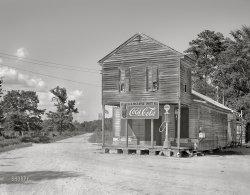
- Dinosaur Garage: 1942
- ... been in existence for over 100 years. Kind of like the blacksmith shop my grandfather used to own.
Wondering about Steam 1. By ... Posted by Dave - 04/04/2021 - 11:04am -
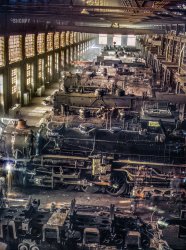
- The Village Smithy: 1937
- August 1937. "Blacksmith's shop turned into a garage. Cambridge, Vermont." Photo by Arthur ... to see The anvil appears to be the last item of the blacksmith's trade showing.
The mechanics chair has been repaired several ... Posted by Dave - 11/25/2017 - 9:17pm -
![The Village Smithy: 1937 August 1937. "Blacksmith's shop turned into a garage. Cambridge, Vermont." Photo by Arthur Rothstein for the Farm Security Administration. View full size.
What's the holiday?Note the calendar. I've searched and can't find out why 16 August, 1937, was a holiday.
Anybody know?
[August 16, Bennington Battle Day, is a Vermont state holiday. -tterrace]
Seeing DoubleSo much to see here!
The stove looks to have been converted to used crankcase oil.
And not counting the multiples of various stocked items... two fire extinguishers and two phones! (Not counting what looks like it may be a third phone in the back corner)
And then there's the mystery of the subset ringer box below what looks to be a first generation Western Electric Model 50A payphone. I guess they wanted the payphone to be able to receive calls too.
All this makes me want to flush out my radiator!
And I forgot to point out the two drills earlier!
That Third PhoneI'll bet it is a battery charger. I count three fire extinguishers including the "Fire Grenade" hanging from the ceiling to the left of the light socket. It looks to be a Shur-Stop — "The Automatic Fireman On The Wall" designed with a lead strip that would melt and allow the glass to break and release the chemical.
These were all filled with carbon tetra-chloride. If the fire didn't kill you, the poisonous gas surely would.
He modified the stoveIt looks like he installed a faucet on top of the stove to drip waste oil into the fire. There is a barrel with stains on the side like oil would make, and the pipe goes directly from the barrel to the faucet. There are rags or clothes draped on the pipe. I'd think that would really make some heat!
It's not a phone.The item mounted high on the wall in the back corner (just to the right of the stove pipe) that looks similar to a telephone is a Battery Slow Charger. The part protruding out the front that resembles the microphone that you would talk into is the Amp gauge, & below that there is a knob you turn to adjust the charging rate. You could charge several batteries at the same time with this set up by attaching jumper wires in parallel between them. My Granddad had one of those from when he had a garage during that period. It's internal circuitry used a very large Tungar Bulb which when in use would glow like an old style radio tube & generated a ton of heat. The sides & top of the box have vent louvers cut into them to help keep it cool during operation. The Tungar Bulb looked like something that you would expect to see in Frankenstien's laboratory.
So much to seeThe anvil appears to be the last item of the blacksmith's trade showing.
The mechanics chair has been repaired several times, using whatever scraps of wood he could find.
Also of interest is the tool chest by his left polished wingtip shoe. There looks like a cooling fan in the side.
Tool chest "cooling fan"I'm going to guess a circular vent with a rotating part which allows more or less air in by varying the opening.
A solitary bombAlso noted: Up in the rafters, a single carbon tetrachloride-filled "fire bomb" - a glass "grenade", usually with lightbulb form factor, held in place by a temperature-sensitive fusible link. When the fire melts the link, the bulb crashes to the ground, and the chemical vapors (supposedly) starve the fire of oxygen. The very, very small fire, that is.
A whiff of a workshop Madeleine?I used to trail around behind my grandfather in his workshop - not nearly as well appointed, but of the same vintage. My west Texas cowboy grandpa was, among other things, a seller of used cars. He would supplement his monthly income by buying, fixing, and selling used automobiles. He had a small garage workshop where he would tune and make minor repairs to clunkers and flip them, pre-Craigslist style, by parking them on a busy street corner with a home-made sign in the window.
By the mid-60's he was out of the car business, but kept his workshop functional. When I'd visit, Ted would usually have some small project waiting for me - sharpening a hatchet, drilling a hole in a broom handle, melting lead for fishing weights. He was not a chatty guy, just gave gentle instruction and guidance (righty-tighty, etc.) When I invariably let go of the wrench to make the final twists of a screw or nut with my fingers, he never failed to say "better use the wrench; you might twist the head off that screw with your bare hands."
Seeing this workshop photo returns me to a recurring theme: our sense of smell and the way our brains organize memory. Our olfactory bulb is part of the brain's limbic system, and the two are very closely related; aromas can call up memories and powerful responses almost instantaneously. I think it must work in reverse, too, because just looking at this photo evokes remembered aromas of:
*oily rags
*gasoline
*sawdust and straw (Ted used to soak up the crankcase fluids with shavings he kept in an old 55-gallon drum)
*warm vacuum tubes from the radio
*rubber tires and belts
*cigar smoke
*percolated coffee
*Vitalis hair oil
*old paper magazines
*whiskey (Granddad normally kept a pint bottle hidden among the oil cans)
*ionized air from the power drill
*West Texas dust and dirt dauber nests
Anyone catch a whiff of other scents?
Other scentsVery fine list of olfactory triggers, Gooberpea. Since you ask, I would add the steel of the anvil, battery acid, and (no disrespect intended) the man himself.
Brands, brands, brandsACME Ventiduct, makers: The Wehrle Co. Newark Ohio
Exide - When it's an Exide you START
Car Battery Hydrometer Tester
Gates Vulco V-belt
Kyanize, Boston Varnish Company, "Coach Black" Car Varnish
oTc (Owatonna Tool Co.) tools
Shur-stop for FIRE: The Automatic Fireman on the Wall
Failed to find the "Tire C(hain?) Chart" from the Columbus McKinnon Chain Corp., nor could I find the Telephone Directory.
Searching for "Socon Super Pyro" I was afraid to get caught for terroristic reasons.
(The Gallery, Arthur Rothstein, Cars, Trucks, Buses, Gas Stations)](https://www.shorpy.com/files/images/SHORPY-8b16707a.thumbnail.jpg)
- Blue Island: 1943
- April 1943. Blue Island, Illinois. "John Kelseh, blacksmith, at his forge in the blacksmith shop at the roundhouse, Rock Island R.R." 4x5 Kodachrome ... Posted by Dave - 08/30/2012 - 4:45pm -
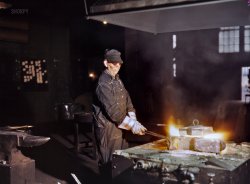
- The Device: 1928
- ... Davenport (1802 – 1851) DC Motor. He was a Vermont blacksmith who in 1834 was credited as the inventor of the first DC electric ... Posted by Dave - 12/31/2021 - 12:40pm -
![The Device: 1928 Washington, D.C., circa 1928. "NO CAPTION" is all it says here. Whatever this is, wires are involved. 4x5 inch glass negative, Harris & Ewing Collection. View full size.
Perhaps a Rotary SwitchThis looks like a rotary switch of some sort. The disk is glass to insulate the wedges on the glass from each other. The wedges on the glass will make contact with the wedges screwed to the back plate to which the wires are attached. As the glass rotates contact will be made and broken at different times for each of the attached wires.
Presumably there is something on the back that will spin the disk, but it can't be very big as it fits in the ladies hand. Perhaps there is a shaft there that would connect to a motor.
I can't identify what it's use was. Blinking Christmas tree lights maybe; that's only a guess though.
Magnetic triggering device?Just a guess, based on the clear (you can see his thumb under the wheel) circle with triangular sections blocked out with tape or something and the 4 equidistant "sensors" surrounding the rotating piece. Reminds me of a crude version of an automotive crank-triggered ignition setup.
Antenna switching device?I wonder if that's an antenna switching device for radio reception. That kind of braided wire is often used for long wire antennas. It really looks like some kind of switch, but it doesn't look as if it's designed to handle much voltage or current.
Some Kind of MotorI wondering if the clear disk is a rotor and the four triangles mounted on the board and wired make up the stator. Science project?
Switch for Antenna Selection?It looks like a rotary switch with 4 postions. Not intended for significant current, so it probably is used for selecting receiving antenna for radio. Spin the glass dial to select. It is not entirely clear how the bottom triagnuar contacts are connected.
It doesn't look like a simple 1 of N selection, but could combine the antennas in certain combinations (e.g 1 + 2).
A 1920's version of a 1830's Davenport DC motor Looks like a teaching version of a Thomas Davenport (1802 – 1851) DC Motor. He was a Vermont blacksmith who in 1834 was credited as the inventor of the first DC electric motor in the US.
Ambiguous PrototypeWhat we have here is the first CPU heatsink prototype, redundant grounding straps and all. Either that, or a long-lost photograph of Benjamin Franklin's new-fangled lightning-kite attachment prototype.
Not Available in StoresIt's a vegetable chopper and potato clock power source.
And the old advice is neededYou have to cut the blue wire first.
Seldom seen nowadaysThose of us old-timers in the graphic arts industry recognize a 1920s manual Pantone-O'Matic, which chose four complementary colors at the push of a button. Gee whiz for its day, and still in use in the mid-1960s.
Invented by Barney Day, younger brother of Benjamin Day, pressman for the old New York Sun.
The little color wheels for this device are still seen occasionally in thrift and antique shops. Folks use them to dazzle and confuse rodents and other household pests.
Antenna tuner/coupler ?Could it be a variable capacitor to tune a wire antenna to a given frequency ?
Looks like it could handle a couple of kV's making it suitable for transmitting as well as receiving.
Whatzit?!?Those braided or twisted leads could carry a fair amount of current, but the paperclip contact to the Device wouldn't. The glass disk hints at high voltage, and with thin pads fixed to the disk, passing between copper contacts around it, it looks a bit like a Wimshurst Machine. Note there are 5 pads on the disk, and 4 sets on the (Bakelite, I believe?) base, so pairs line up sequentially, but never all at once.
What momma used to say"It's dirty, don't touch it!"
Field MillUsed to measure small static (Direct Current) charges. The rotating shutter would convert the direct current to alternating current which was more easily measured with the equipment of that time.
When trying to measure a small static charge back then, you would have major problems with drift and noise.
http://www.missioninstruments.com/pages/learning/about_fm.html
https://www.instructables.com/E-Field-Mill/
Strobe LightYou're all wrong. It's a strobe light.
Variable capacitor?Several good guesses already. My guess is that it's a prototype variable capacitor, such as might be used in a radio tuning circuit.
As far as I can tell My first guess was a device to measure the speed of light, because it looks like the one that kid on Bonanza invented for the same purpose. Except his was manually operated.
Time Lord TechnologyOf course it is difficult to identify as it is the variable tuning apparatus (which sits inside the control console) and is attached to the control handle for the Zig Zag Plotter on a Type 40 TARDIS.
Holy Hypno!I think the Penguin used this same device to hypnotize Batman. But in color.
SequencerMy take on this gadget is that it's for sequencing 'traveling lights' on advertising signage.
Each of the static contact are visibly offset from the rotating contacts by different amounts so they would make and break each of the 3 (or is it 4?) circuits at different times. This would result in the illusion of motion for whatever lights were connected.
Well, clearly it's a ... a ... um ...The triangle contactor on the upper left has a wire leaving it, which appears
to go under the glass disk to the loop and wire on the lower right, and also
to connect to the lower-right triangle contactor.
The lower left triangle similarly seems to have a wire that goes behind the board
and around to the upper-right triangle/contactor.
The metal on the glass disk at the lower left appears to have a triangular
piece of wire that sticks up to make contact with the lower-left stationary
triangle contactor.
As others have observed, they are all offset to make/break contact in sequence.
If it's for sequencing marquee lights, why did someone need to make a glass
negative of that??
[The Library of Congress archive contains thousands of photos of various inventions, gizmos and gadgets. - Dave]
It slices! It dices!That's Ron Popeil's mother holding the device, a very early prototype of the Veg-O-Matic.
The only thing I can say for certainIs that thing could use a good cleaning.
Interesting clueNote that there are four triangular flanges over the wheel, yet on the wheel itself there are five triangular patches, presumably to block (or make) electrical contact. My guess is thus similar to JohnHoward's, that it's for advertising signage -- you get contact (and thus lights) moving forward or backward faster than the speed of the rotating disc. Think period movie palaces, with big flashing neon displays; something had to run them, and this was going to be the next big step forward.
What is it?It looks like some sort of switch or distributor.
(Technology, The Gallery, D.C., Harris + Ewing)](https://www.shorpy.com/files/images/SHORPY-34730a.thumbnail.jpg)
- The Blacksmiths: 1904
- Despatch, New York, circa 1904. "Blacksmith shop, Merchants' Despatch Transportation Co." Operations of the ... rod for brakes.
This is a common layout for a RR blacksmith shop. They would have made mostly things like grab irons, uncoupling ... Posted by Dave - 07/19/2012 - 10:21pm -
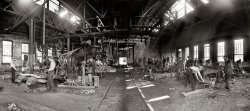
- Town Building: 1907
- ... and instruct its Selectmen to purchase the Ladd and Bunker blacksmith shop lot, so called, situate on Union Street in Littleton village, ... Selectmen be instructed to purchase the Ladd and Bunker blacksmith shop lot, so called, situated on Union Street in Littleton Village, ... Posted by Dave - 05/31/2013 - 10:44am -
![Town Building: 1907 Circa 1907. "Town Building, fire station and opera house -- Littleton, N.H." Coming Aug. 26: Gorton's Famous Minstrels. 8x10 glass negative. View full size.
First-Class Wooden Building
History of Littleton, New Hampshire, 1905.
James R. Jackgon
Annals. 1870—1903.
… In view of these facts and the further fact that the town and Village District are now paying as rent for insufficient and unsuitable accommodations for town and district office and business a sum much larger than would be required to pay the interest on any indebtedness which would be incurred in building a first-class wooden building with fire-proof vaults for town records suitable and convenient for all town and village purposes and which would be an ornament to the town, we recommend that the town vote to bond itself, for not exceeding $15,000.00, and instruct its Selectmen to purchase the Ladd and Bunker blacksmith shop lot, so called, situate on Union Street in Littleton village, provided it can be purchased at a reasonable price, and if not, cause the same to be condemned as a site for a town building, and to erect thereon, during the coming season, a handsome wooden building, containing a fire-proof vault for the town records, and finish therein a Town Hall, Selectmen's and town clerk's office, police court room and lobby, also for the temporary use of the town library until such time as a fire-proof library budding and memorial hall can be constructed by gift or otherwise; also suitable rooms for the fire department of Littleton Village District and for storage of its tools and other property, provided the Selectmen can make satisfactory arrangements with said district to lease the same.…
The report of the majority of the committee having been adopted, Daniel C. Remich moved, “That the Selectmen be instructed to purchase the Ladd and Bunker blacksmith shop lot, so called, situated on Union Street in Littleton Village, if it can be purchased at a reasonable price, and if not, cause the same to be condemned as a site for a town building, and to erect thereon during the ensuing season a handsome wooden building containing a fire-proof vault for the town records, and finish therein a Town Hall, Selectmen's and Town Clerk's office, Police Court room and lobby. Also provide therein suitable accommodations for the temporary use of the Town Library until such time as a fire-proof Library Building and Memorial Hall can be obtained by gift or otherwise. Also suitable rooms for the Fire Department of Littleton Village District and for storage of its tools and other property, provided the Selectmen can make satisfactory arrangements with said district to lease the same and to pay for said land and erect said building. The Selectmen are authorized and instructed to issue in behalf of the town not exceeding $15,000, of bonds bearing four per cent interest, payable in thirty years from date, with a right reserved in said bonds to pay the whole or any portion of said bonds after ten years from their date. In constructing the town building herein proposed local laborers shall be employed provided they can be secured at reasonable American wages, which is on the basis of $1.50 per day for a good common day laborer, and provided further that sufficient numbers can be obtained.”
Shout "fire" in a crowded theatreAs long as it's loud enough for the firemen downstairs to hear.
Under restoration! At least as of this Streetview shot:
View Larger Map
Mileages?I looks like they are installing screening on the cupola at the top of the building. From the amount of bird/pigeon droppings just below the weather vane, I can understand why they would.... or maybe to prevent lovers from leaping?
The hand sign pointing right that says: MILEAGES; what does that mean?
[Well, whatever else, they have low rates. -tterrace]
Re:Mileages?The "hand signs" pointed the way to the towns of Bethlehem, NH and Franconia, NH, both approx 5 miles down the road.
The "Mileages - Low Rates" was separate and was where you paid freight for the transportation of goods. Freight was assigned a rate per 100 lbs., depending on the commodity being shipped. Perhaps this is where they were provided rail distances between cities and the rates to transport different materials?
Total guess?
Restoration!It makes me so happy to hear that one of the beautiful buildings in one of these pictures has both escaped the wrecking ball. The fact that it is even being restored is even better!
Early Example?Multi-Use building. A three-in-one special. Cool.
"Mileages" SolvedFranconia is 5 miles due south of Littleton, NH.
Bethlehem is 5 miles due east/southeast of Littleton, NH.
What they apparently don't want you to know is that Franconia and Bethlehem are in neighboring Vermont.
[Around the corner there's another hand pointing in another direction to Bethlehem, also 5 miles. -tterrace]
Coming SoonGorton's New Orleans Minstrels!
(The Gallery, DPC)](https://www.shorpy.com/files/images/SHORPY_4a18372a.thumbnail.jpg)
- Wheelwright Shop: 1862
- ... the war effort. The armies in the field did have traveling blacksmith forges and mechanics--part of the Quartermaster and Commissary ... Posted by Dave - 08/01/2012 - 3:19pm -
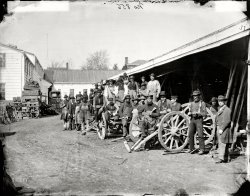
- Hammer and Tongs: 1943
- ... Hammering out a drawbar on the steam drop hammer in the blacksmith shop." 4x5 Kodachrome transparency by Jack Delano for the Office of ... Posted by Dave - 08/05/2012 - 6:38pm -
![Hammer and Tongs: 1943 March 1943. "Santa Fe R.R. shops, Albuquerque. Hammering out a drawbar on the steam drop hammer in the blacksmith shop." 4x5 Kodachrome transparency by Jack Delano for the Office of War Information. View full size.
Drawbar 101Drawbars formed a quasi-permanent connecting link between a steam locomotive and its tender. It needed to be physically robust and have exceptionally high tensile (stretching) strength, since it would bear the entire starting/rolling load of a train weighing several thousand tons. The "hammering" you see in the photo was part of the forging process that imbued the drawbar with its strength. Early diesel locomotives experimented with drawbars, but since diesels carried their own fuel, drawbars created an unnecessary limitation to mixing and matching locomotives and were quickly abandoned as a relic of the steam age.
One sturdy chainI admittedly know nothing about metal working but I'm a bit surprised that the big orange glowing bar isn't melting that chain.
The ChainPretty basic explanation about the chain - if the temperature isn't hot enough to melt the steel drawbar it wouldn't be hot enough to melt the steel chain. In hot working like this, the lower limit in terms of temperature is 2000 degrees Fahrenheit. Melting point of steel varies by the alloy, but it often melts at 2500 degrees Fahrenheit.
Diesels & DrawbarsActually it wasn't an experiment. Diesels were connected by drawbars for several reasons.
EMD had considerable success with its prewar E units, which carried a pair of prime movers on a single long frame. Railroads liked the concept, but the new, bigger and heavier 567 prime mover designed for the F series freight diesels made this impossible. EMD solved this with the cabless booster, or B unit, which was connected to a standard A unit with a cab. An A-B set is really one locomotive with two prime movers, albeit not under the same body.
Union rules at the time required that each locomotive have an engineer and fireman. So if you wanted to run an A-B + B-A or A+A set of new diesels, you paid two crews. Connecting two, three or four units as one with drawbars (A-A, A-B-A or A-B-B-A) allowed the railroads to circumvent this. And on many railroads, these multi-unit sets all carried the same number, but each had a different letter, such as 1091A, 1091B etc. for the same reason.
The biggest headache was maintenance – if one unit went down, all had to be taken out of service. As diesels took over, the old rules were finally abandoned, and F units were fitted with standard knuckle couplers so they could be mixed and matched as needed.
Diesels & Drawbars & Santa FeI don't disagree with the discussion on drawbars on diesels, however the shops in Albuquerque were Santa Fe, one of the first railroads to reject the concept of fixed consists in favor of couplers on all units. According to most of the normal sources (McCall's "Early Diesel Daze", for example), this started with the very first road freight locomotive they purchased, FT 100.
It looks to me like they've only just started forging whatever they're making and it's a little too early to say what it's going to be. It could very easily be a side rod or main rod for a steam locomotive.
[We think it's a drawbar because it says so in the caption -- which was written by Jack Delano, who took the picture. - Dave]
The bar and the chain are both steel.It is certainly possible for the work to head up the chain to glowing, but seeing as both of them are the same material it is impossible for it to melt the chain.
Also they are turning the bar ninety degrees between passes to draw it out square. (Drawing round under flat dies is a bad idea.) Turning the bar brings a different section of the chain in contact with the hot bar. Also the area of contact between the chain and the work is fairly small so the transfer of heat would be slow.
More Santa Fe railroad shop picturesHere are some additional pictures of the Santa Fe railroad shops, including several shots of that very same steam hammer and the nearby forge. Other pictures in the series confirm that it is indeed a drawbar being forged. The temperature of steel at orange-yellow is about 1800F. The melting point of steel is around 2500F, depending on the alloy.
DANGEROUS WorkThis was Dangerous work, with a capital D.
Nothing like blunt, super-heavy red hot machinery to put human vulnerability into sharp relief. When I see a picture like this I feel a surge of patriotism, despite my cynical metro-self. Dang it, there was a time in this country that when we needed something made or built, we made or built it, right there and then.
[What country is the planet's current No. 1 producer of manufactured goods? It is still the U.S. of A. - Dave]
(The Gallery, Kodachromes, Jack Delano, Railroads)](https://www.shorpy.com/files/images/1a34730u.thumbnail.jpg)
- Henry Lincoln Johnson: 1914
- ... and trust with dignity and ability. Starting in life as a blacksmith, he has forged to the front, step by step, and today stands second ... but had been free people and mechanics. For 80 years a blacksmith shop had been run by members of the family continuously, his ... Posted by Dave - 09/12/2011 - 2:16pm -
![Henry Lincoln Johnson: 1914 Washington, D.C., 1914. "Henry Lincoln Johnson, Recorder of Deeds." Harris & Ewing Collection glass negative, Library of Congress. View full size.
Job descriptionI think I'd like to be a Recorder of Deeds but I'm not sure exactly what it entails.
Sgt. Henry JohnsonHenry Johnson was one of the first American soldiers to be awarded the Croix de Guerre by the French government in World War I.
http://en.wikipedia.org/wiki/Henry_Lincoln_Johnson
[Born 1897 -- that's a different Henry Lincoln Johnson. Our man in the photo was born circa 1870. - Dave]
Recorder of DeedsFor those (like me) who are not familiar with the term:
The Recorder of Deeds, an administration in the Office of Tax and Revenue, is the official repository of all land records and general public instruments [in this case] for the District of Columbia. The office is responsible for the collection of all recordation and transfer tax and filing fees on instruments being recorded and maintains these records for public inspection.
Henry L. Johnson - BioMethinks H.L. Johnson is a very handsome man (possibly another Handsome Rake candidate?). One of the following article contains a euphemism unfamiliar to me, namely slavery referred to as "the badge of servitude": the use of the word badge makes it sound as if the writer believes enslavement to be an honored position.
Update: In 1903, Henry Lincoln Johnson married poet Georgia Blanche Douglas Camp. [note: Wikipedia currently has an erroneous link regarding Georgia's husband to the aforementioned recipient of the French Croix de Guerre.]
The Johnsons lived at 1461 S Street NW: more info
New Recorder of Deeds
Henry Lincoln Johnson, of Atlanta, Ga., new recorder of deeds of the District, assumed his duties yesterday morning and was accorded a reception by the employees of the department. ....
Washington Post, May 3, 1910
Henry Lincoln Johnson
Recorder of Deeds, District of Columbia
The subject of this sketch, Henry Lincoln Johnson, Recorder of Deeds, of the District of Columbia, is filling a public position of responsibility and trust with dignity and ability. Starting in life as a blacksmith, he has forged to the front, step by step, and today stands second to none of the leaders of his race.
Mr. Johnson is still a young man, having been born in Augusta, Ga., July 27 1871. For several generations back his ancestors had not known the badge of servitude, but had been free people and mechanics. For 80 years a blacksmith shop had been run by members of the family continuously, his grandfather, father, and himself all having been engaged in the trade, and all born in the same humble home, but one which was their own. Henry L. Johnson was educated in the common and high schools of Augusta, Ga. For a time he taught in the country schools, and by hard work and perseverance gained a classical course at Atlanta University, Georgia, and a thorough legal preparation at Ann Arbor, Mich.
After graduation from college Mr. Johnson became a member of the Atlanta, Ga., bar, and engaged in the general practice of law. He became actively interested in politics, and in 1896, 1900, 1904, 1908 and 1912 he was delegate at large from Georgia to the Republican national conventions. He also had the honor of instituting the first peonage prosecutions in the United States. Coming to Washington, his splendid service in behalf of his party and race was rewarded by his appointment to the office he now holds.
Mr. Johnson is interested in the Union Mutual Insurance Company, Atlanta, Ga.; The Atlanta Mutual Insurance Company, of Atlanta. He is a Mason, a Knight of Pythias, and an Elk. He is also an Odd Fellow, and is attorney for that order in Georgia.
Washington Post, Jun 12, 1912
Negro Elks Unveil Johnson Memorial
More than 2,000 attended the unveiling of the Henry Lincoln Johnson Monument yesterday in the Lincoln Memorial Cemetery on the Suitland road, under the auspices of the Henry Lincoln Johnson Lodge of colored Elks, of New York. The lodge brought 500 members and a band from the metropolis and joined by Columbia and Morning Star Lodges, and Forest and Columbia Temples, marched from the Columbia Home on Rhode Island avenue to Third and F streets southwest, where buses were taken to the cemetery.
...
Henry Lincoln Johnson, former recorder of deeds here, and Republican national committeeman for Georgia, was eulogized by J. Finley Wilson, grand exalted ruler of colored Elks. The monument, erected at the instance of Robert R. Church, Perry W. Howard, John T. Risher and the grand exalted ruler, was unveiled by Hubert Pierre, exalted ruler of Henry Lincoln Johnson Lodge, and Ada Mercer, daughter of ruler of Apex Temple.
Washington Post, Jun 27, 1932
"The badge of servitude"That's not a euphemism. A badge is a symbol or token, not necessarily of anything good or honorable. Some Shakespearean examples: "Black is the badge of hell; the badge of pusillanimity and cowardice; heavy tears, the badge of woe."
Recorder of DeedsSounds almost biblical!
1871-1925There is a Washington Post obituary dated 9/13/1925 that mentions the Recorder of Deeds and he died of a stroke (not his first). He was from Georgia and his parents were slaves and graduated from Atlanta university and went to law school in Michigan. He was a delegate to the Republican National Convention in 1896. His address at the time of his death seems to be 1461 S St. NW. Calvin Coolidge contributed a letter read at the funeral.
(The Gallery, D.C., Harris + Ewing, Portraits)](https://www.shorpy.com/files/images/04439a.thumbnail.jpg)
- Lemon H. Wiley: 1862
- ... 17, 1844. His father, also a native of that place, was a blacksmith and wagon maker by trade. In early life he was elected justice of ... He was too much of a musician, however, to make a good blacksmith, although he entered his father’s shop and attempted to learn the ... Posted by Christoph Traugott - 04/28/2019 - 5:10pm -
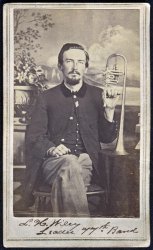
- The Old Hard Shoe: 1939
- June 1939. "Ruins of blacksmith shop. Virginia City, Madison County, Montana." Photo by Arthur ... Montana. -tterrace]
It's a joke! The town blacksmith was John P Uren, born England about 1850, died Montana 1928. Remove ... Posted by Dave - 12/07/2017 - 7:07pm -
![The Old Hard Shoe: 1939 June 1939. "Ruins of blacksmith shop. Virginia City, Madison County, Montana." Photo by Arthur Rothstein for the Farm Security Administration. View full size.
FootprintsI could tell from the first glance that there was a small gift hidden in this photograph. A few seconds later, there it was: the line of child's footprints across the board over the window. This vision of delicate absurdity breaks the paralyzing stillness of the old photograph like a cast stone breaks the stillness of a pond.
U.P. Uren?I should hope so!
Child’s footprintsWe used to make those on chalkboards. Make a fist and press the side with your pinkie on the chalk board and rub very slightly. The impression looks like a foot sole. Then take your finger and make the five toes. Looks just like a baby’s footprint. Although I think this jokester used paint?
What a Bonanza!I'll bet that Ben Cartwright used to hang around that place.
[The Ponderosa was big, but it was a far piece from Montana. -tterrace]
It's a joke!The town blacksmith was John P Uren, born England about 1850, died Montana 1928. Remove the periods and the two words become "Up Uren". John P. Uren would have made a nice Shorpyite.
The sign seems to have held up well in the 11 years since the owner’s death.
[Yes, it's a joker's hand. There's no doubt about it. -tterrace]
(The Gallery, Arthur Rothstein, Small Towns)](https://www.shorpy.com/files/images/SHORPY-8b17661a.thumbnail.jpg)
- Big Steel: 1941
- ... gone by the time I was born in 1961. My grandfather was a blacksmith for Spangs steel mill in Etna. I believe these may have been along ... Posted by Dave - 08/03/2012 - 10:34pm -
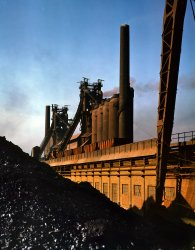
- 1st Division Mechanics: 1864
- ... although again, the actual job description may have been "blacksmith." (Blacksmiths were generalists, expected to shoe horses or mules ... Posted by Dave - 04/10/2008 - 3:02pm -
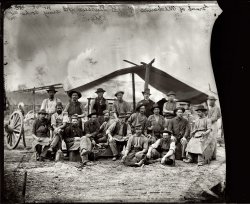
- Exchange Court: 1920
- ... when my hometown outside New York City still had a blacksmith.
I remember in the mid 60s a junk man in a horse drawn carriage ... Posted by Dave - 08/10/2012 - 3:47pm -
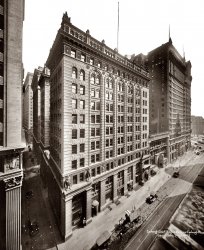
- T Time: 1924
- ... looks like the backstore of the neighbourhood's blacksmith; but it's really interesting to see how the Flivvers were displayed ... Posted by Dave - 09/04/2012 - 12:03pm -
![T Time: 1924 "Strobel Motor Co." New Model T in a Washington, D.C., Ford showroom circa 1924. National Photo Company Collection glass negative. View full size.
Lincoln?The name Lincoln appears in the front window, just ahead of the larger Ford script. The dealership's name and address are unrelated to the name Lincoln and Lincoln cars have seldom been sold by Ford dealers. Does anyone know the actual significance of the Lincoln name on this window?
[The obvious answer might be that they sold Lincolns and Fords. Ford owned Lincoln; there were lots of Ford-Lincoln dealerships. Below are two more examples from the Washington area. - Dave]
High TechThe most modern piece of equipment in this picture is the metal file cabinet, which has not been improved upon since.
High tech?Actually, omitting anything to do with the car itself, the high-tech award should go either to the phone box on the baseboard on the left, or to the clock/timer thingy above the left corner of the window that sjmills pointed out. As to the latter, is it merely a clock, or a timing device? Rather poor design for a clock, as it's difficult to see if there are any hands. If a timer, is it for the lights as suggested, or maybe a burglar alarm? There appear to be thick black cables coming from the bottom of the case, and there's a round gizmo on the wall immediately below it, although that may be a light fixture.
Spare tireActually, that was the latest innovation in wheels at the time: they were called demountable rims. When you had a flat tire, you merely unbolted the rims and pulled it with the tire, replacing it with the one you carried behind the car, pretty much as we do today. Before that, it was expected from the user to know how to fix a punctured tube right on the spot.
Of course the spare wheel and its corresponding innertube were extras, not included in the extraordinarily low price of the Model T.
No Stranger to FordsWashington Post Oct 9, 1921
Another Ford Agency
Strobel Motor Company Added to List of Dealers
To sell Fords at retail, E.T. Strobel has organized the Strobel Motor Company, and opened a sale and service station at 1425 Irving street northwest.
To the Ford automobile, Mr. Strobel is no stranger, having for twelve years been a superintendent of assembly for the factory, and the first to supervise the assembly of Ford cars in the Washington plant on Pennsylvania avenue. After severing his connection with the company, he accepted a position with the R.L. Taylor Motor Company, Ford dealers, as superintendent, which position he occupied until engaging in business for himself.
In his new quarters he has ample room to render service on Ford cars, there being 17,000 square feet available. The shop is equipped with all the latest time-saving machinery, including equipment for rebabbitting bearings and reboring cylinders.
Update: Mr. Strobel's business venture lasted for a few years but eventually dwindled. The October 9, 1927 Washington Post reports that the space at 1425 Irving street being used as the service department for I.C. Barber Motor Co.
Lost eraContrast this bare bones showroom with the slick extravaganza at todays Auto Mall. The earnest fellow with immaculately-oiled hair and a straw skimmer on his desk trying to sell you sisal floormats and a manifold heater might have been just as skeevy as todays Herb Tarlek Jr. pitching undercoating, but when he ducked into the back room he really was talking to the manager.
Spare?Not a tire, not a wheel, just a rim.... now that's some early work in changing tires!
AutomationIs that a timer to turn on the lighted signage?
Amazing tonal rangeEverything from under the wheel wells on the dark side, to what's outside the window. Those days (in one shot, anyway) are gone, I guess.
Mission StatementNote the mission (or "arts and crafts") style chairs. This furniture was a bit out of fashion in the home by this date, though obviously still considered to be fine for this commercial setting.
In - T - resting!This showroom is a very far cry from today´s glass and aluminum dealerships! looks like the backstore of the neighbourhood's blacksmith; but it's really interesting to see how the Flivvers were displayed back in the day.
By the way, notice the little stains on the floor; I know that Model T's were "supposed" to leak some oil from time to time, but jeez, these were new cars!
Nice photo as always.
Marking the TerritoryModel T's had no dipstick. To check the engine oil you leaned under the car and opened a petcock, if oil ran out you were good to go. No drip, you neeed to put some in.
A few drips of oil back then was looked upon as better than the 24 pounds a day of manure from the horse the T replaced.
Lincoln Ford FordsonThe sign in the window also reads "Fordson". They sold Fordson tractors as well
(The Gallery, Cars, Trucks, Buses, D.C., Natl Photo)](https://www.shorpy.com/files/images/32346u.thumbnail.jpg)
- Knott's Berry Farm 1958
- ... would lend you a feathered headress), you could watch the blacksmith make a horseshoe, pan for gold (you would get to keep the gold dust ... Posted by notycoon22 - 09/22/2011 - 11:29pm -
![Knott's Berry Farm 1958 Was reading an article by Steve Martin the actor/comedian in the New Yorker the other day and he mentioned that he'd started his career in show business at Knott's Berry Farm in the 60s. Wandering through some old family slides and, lo and behold, here's a shot from 1958. Predates Martin a bit, but I'm guessing it looked pretty similar. Oh, and that's my family on the right.
Photographer: Don Hall Sr.
Don Hall
Yreka, CA
View full size.
Thanks for posting thisAs a wee lad in the 1963-65 timeframe I went to both Knott's Berry Farm and Disneyland. Mouseville was much more entertaining, and all the photos and film clips set at Disneyland have reinforced my memories of that place.
But . . . why so little media attention to the Berry Farm? About all I remember of visiting there was learning they made jams and jellies.
Looks like a place I'd enjoy a lot more as an adult.
Knott's Berry FarmSadly, I can't remember Knott's Berry Farm, but I know I went to it and Disneyland when I was about 2-3 when we lived in Redondo Beach, Ca. in the early to mid 60's. But my mom loved it and often talked about it.
In GOD I trust, JOY
Knott's Berry FarmIn the 1960's the hippies started hanging out and sleeping in the trees and such. Fences were put up and then admission became the way of things. Before that the place was wide open. Some of the employees refer to those days as BH, for before hippies. I grew up near there and most folks in the area had very fond memories of the place. It is owned by big business now and just not the same.
Walter Knott's PlaceI went there during the 40's and 50's, when I lived in Manhattan Beach. There was no central admission point, you simply wandered from building to building. I believe the owners also owned Calico, a "ghost town" out in the desert.
Steven
Knotts Berry FarmI worked at Knotts on and off from 1956 thru 1960. It was all open when I worked there, but we had to move because my daughter, who was 2 years old, was allergic to the smog, and the doctors said she could lose her eyesight if we stayed there. I believe the fences went up and admission charged in the late 60's, because you could have picnics anywhere on the grounds, but no alcohol was allowed on the place when I worked there. People started drinking, leaving beer bottles on the lawns in the picnic areas, and abusing the Knotts family generosity. The Knott family treated their employees as family. I loved working there.. My whole family worked there. My dad Ed Kingsley was foreman of the stage line, my brother Eddie drove covered wagon, my mom Sibyl and sister Rita ran the burro ride. My brothers Dick and Treat robbed the stagecoach and covered wagons.
What fun memories, summers, by the time we got off work it was usually about 11 PM... Often all the cowboys from the stage line, the Indians and the girls from the Grill would head for Huntington Beach and build a big bonfire, roast hot dogs and marshmallows and body surf by moonlight. What wonderful memories I have of those days.. Or all of us heading to Pasadena for the Rose Bowl parade. Dad and his boss Bill Higdon driving stage, all heading to my aunt's afterward for waffles. I remember Bill Hidgon had long white hair and beard and always wore a red long sleeved shirt. My little cousins thought he was Santa Claus. I would love to step back in those times once more.
50 Years of visiting Knott'sMy family moved to the area in 1958. We started visiting KBF on a regular basis. It was all free then and we enjoyed walking around the ghost town. My brother & I usually ended up chasing the chickens around in the parking lot. Years later I "donated" two roosters, Charlie & Oscar, to their collection as we couldn't keep them at home anymore. A girlfriend's father, Russ Wildey, was one of the piano players in the old saloon in the early & mid 60's. I had an older female cousin who was dating one of the train robbers at that time. KBF was a lot of fun for us kids then. Actually I liked it a lot more before they fenced it in, but understand why it was necessary. I now take my grandkids there and love seeing them having their own fun.
Knott's Berry FarmIn the 1960s I would visit almost every day to listen to the Wagon Masters, the beginning of my love affair with folk music. I have been looking for their records (LP'S or any format). To my surprise on one of my visits back to KBF, the present employees of the park do not know The Wagon Masters.
[You should look on eBay. The group's name is the Wagonmasters -- one word. Currently there are eight Wagonmasters albums for sale. Click here. - Dave]
Married to a Wagonmaster!Hey email me...I'm married to Harvey Walker, back row, far right. I can tell you where you can get all the albums, now in CD form. Thanks for remembering them. Rachel has passed away, as well as Bobby (back row, far left. KC@KCDOUGLAS.COM
Train robbers.My sister and I went on a road trip with our grandmother and her sister from S.F. Bay Area down to see Disneyland around 1958. That was one long trip in those days. Disneyland was great of course, but I really liked Knott's Berry Farm. I was 5 years old, and cowboys were a big deal for kids my age. It really felt like I was back in the frontier days.
So we decide to take the train ride, and everything was really neat. The all of a sudden, these two guys in masks kick in the door to the train car we were on and shoot off their guns and yell out that this is a robbery.
Well nobody told me that these guys weren't actual train robbers, and I was scared out of my mind. All could think off was, "Please don't kill my Nana." The panning for gold was also a big hit with me. I'm pretty sure I still have the little tube with gold in it stashed somewhere.
Russ Wildey, my dad.Russ also played piano at Disneyland, Shakeys, and the Gaslite Lounge in the 1950s & 60s. Born in 1900, he was most famous in the 1920s. He and his partner Bill Sheehan were known as the Ray-O-Vac Twins. They worked for RKO Radio making appearances across the country and playing live broadcasts. Bill sang while Dad played the piano. Their sheet music is still sold online. It's fun to see his picture on the covers, looking so young. Dad passed away in 1964, I was 13.
The Good Old DaysIn 1968 the fence went up around Knotts Berry Farm. I remember because I was ten but my best times there were when it was still an open park. It had been an open park dating back to when it was not much more than a berry farm and berry stand on the side of the road in the 1920's. They served boysenberry pie, that was the only berries they grew or sold. No one else grew or sold boysenberries so it was quite unique and soon the crowds came. By my time it had already grown into a successful theme park many years earlier. But I do remember the days in the 1960's when Steve Martin not only played at the Bird Cage Theater but would walk to the stunt man show and do their crowd warm-up. He would joke around while people came in to find seats in the covered wagons that surrounded the stage and then joke around a little with the stunt men at the beginning of the show. He wore a giant funny cowboy hat, like they do at football games now, and I remember him being the funniest guy I've ever seen. So I've literally been a fan of Mr. Martin from the beginning.
As far as Knotts Berry Farm goes, there were nice tree covered parking lawns on three sides and you could enter the park from all sides. The front entrance was the most popular because that's where the restaurants and shops were (and still are). They also used to have a San Francisco style cable car (on a track) that ran to the front parking area and dropped you off right in the center of the park between the train depot and stage depot. You bought attraction tickets at various ticket booths just like you would at a neighborhood carnival and they were just a little smaller than a DO NOT DISTURB sign for a hotel, like train tickets, so the ride operator could punch it and it became a souvenir. They were used for the train, stage, calico coal mine ride, haunted shack, mule ride, and various old-style amusement park rides.
There was also Old MacDonald's Farm with a petting zoo and a chicken that would play the piano if you dropped a nickel in a slot to release feed on the keys. There was an organ grinder with a monkey who would untie your shoes and take your dime, and a goat that always seemed to be standing on the peak of the barn roof.
Free attractions included lots of historic structures including the original Knotts Berry stand, a real country church with steeple that held the only regular services within an amusement or theme park (also weddings), a small chapel created by a local artist that showed the transformation of Christ via a wall to ceiling stained glass and special effects lighting and music. Lots of little narrated shows like a 3D panorama showing Mrs. Knott's grandmother crossing the desert in a covered wagon and begging for water. It was only six minutes long but after the little girl cried "mommy, can I please have a drink of water" and her mother replying "I'm sorry we have to save it for the horses, try to get some sleep now" there wasn't a dry eye in the house. Models of all the missions in California were depicted in scenes along a covered walkway, I doubt any kid would stop to look at those today. There were shootouts to watch and you could get your picture taken with saloon girls or the Indian chief (who would lend you a feathered headress), you could watch the blacksmith make a horseshoe, pan for gold (you would get to keep the gold dust in a little bottle), watch a corpse rise from the undertakers carriage, walk around boot hill, and talk to Sad Eye Joe in his jail cell who despite being just a stuffed dummy, spoke to you and always knew your name and everything else about you (he's been there since 1940 but if your parents aren't there talking to his partner around the corner he might not remember your name). Some of that still exists, but basically its just Knotts in name only, quite a different park exists there now and much of what I described torn down or slated to be torn down.
The jellies are now owned by Smuckers and the park by Cedar Fair who's opinion is if its not a fast ride, bulldoze it down, historical who cares. The old church which looks like a Thomas Kinkade painting is being destroyed because they don't want the expense to move it. The old chapel was torn down and the artwork (smashed?). Founder Walter Knott was such a lover of American history he built a replica of Independence Hall in the 1970's including the Liberty Bell and a tour that recreates the signing of the Declaration of Independence. Cedar Fair decided to keep it because it was so accurate Hollywood uses it for movies (National Treasure, for example) and it pays for itself that way.
I remember learning a lot about history at Knotts Berry Farm and what it was like to live a hundred years in the past. I learned it was all about the various people who were each distinct characters in the town. Now its just about indistinct roller coasters with indistinct roller coaster operators and indistinct roller coaster riders having indistinct roller coaster experiences that will last as long as it takes to run to the next roller coaster.
Old Church ChapelMy mother worked in the Chicken House around 1959-1960. I remember as a little girl going to a little Church Chapel with big doors that opened and you would go in and sit down and see and hear a story about Jesus. Does anyone know if that little church is still there? I also remember feeding the seals after Momma got off work.
(ShorpyBlog, Member Gallery)](https://www.shorpy.com/files/images/KnottsBerryFarm1958mr.thumbnail.jpg)
- Telco Garage: 1919
- ... motors. For a currently working wrought iron and blacksmith shop set up to run from a line shaft powered by a 15 hp 1898 Reid, ... Posted by Dave - 10/05/2012 - 11:30am -
![Telco Garage: 1919 Washington, D.C., circa 1919. "Chesapeake & Potomac Telephone Co. garage." Harris & Ewing Collection glass negative. View full size.
Re: Modern shopNixiebunny, I think the first stationary electric powered tools date from the late 1880s, so I think at least some would have been available in 1919. However, I think you're right that these were intended to be driven by belts from a line shaft and were converted to individual motors. For a currently working wrought iron and blacksmith shop set up to run from a line shaft powered by a 15 hp 1898 Reid, see http://www.sandersoniron.com and follow the "Studio" link. I think it's absolutely amazing.
For anyone in southern California who hasn't seen an old shop like this in person and wants to, the Carlsbad Antique Gas & Steam Engine Museum has a running wood shop with everything running off of a line shaft that's powered by a big stationary steam engine. Lots of other fascinating stuff there, also.
I've seen this Prison Movie!The guy with the Boring Bar is upset because "Pretty Boy" is always front and center in all the pictures, well he'll just have to do something about that, something involving an "accident" with a Chain Hoist! Bwahahaha..
What a Revoltin' DevelopmentTo the left, we have Chester A. Riley, long before his stint at Cunningham Aircraft, performing a tuneup on the ol" flivver.
Slicker than....Please wipe your feet before leaving garage.
catch the tubeI wonder if the logo on the guy's cap refers to this?
Modern shopAll the machine tools (lathe, grinder etc.) are belt-driven units that have been fitted with individual electric motors. It may not have been possible to buy motor-driven machine tools at that time.
ConduitWere they using conduit like this in 1919? It looks pretty contemporary for 1919. I figured all wiring in that time frame would have been knob and tube. I'm thinking more like the 1930's here.
[Take a close look at the license plate. - tterrace]
Belt Driven MachineryI worked in a machine shop in the mid 80's. We several machines including a lathe with a 100 inch swing that had been belt driven originally. Who cares? It's a lathe .. or .. a mill .. a drill press. Just a machine. That 100 year old lathe was much cheaper then a new one the same size but does the exact same job a newer one would do.
BravoOne off the best pics on Shorpy to date. I'm there.
(The Gallery, Cars, Trucks, Buses, D.C., Harris + Ewing)](https://www.shorpy.com/files/images/SHORPY_20540a.thumbnail.jpg)
























